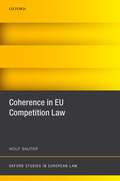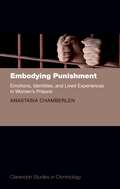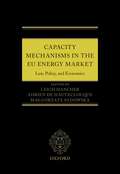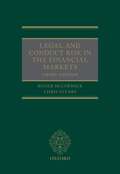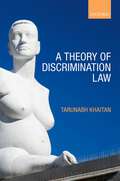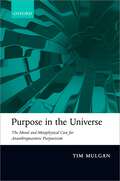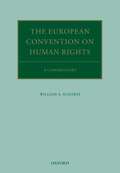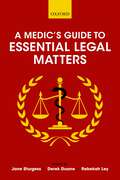- Table View
- List View
Economic Governance in Europe: Comparative Paradoxes and Constitutional Challenges (Oxford Studies in European Law)
by Federico FabbriniThe Euro-Crisis and the legal and institutional responses to it have had important constitutional implications on the architecture of the European Union (EU). Going beyond the existing literature, Federico Fabbrini's book takes a broad look and examines how the crisis and its aftermath have changed relations of power in the EU, disaggregating three different dimensions: (1) the vertical relations of power between the member states and the EU institutions, (2) the relations of power between the political branches and the courts, and (3) the horizontal relations of power between the EU member states themselves. The first part of the book argues that, in the aftermath of the Euro-crisis, power has been shifting along each of these axes in paradoxical ways. In particular, through a comparison of the United States, Fabbrini reveals that the EU is nowadays characterized by a high degree of centralization in budgetary affairs, an unprecedented level of judicialization of economic questions, and a growing imbalance between the member states in the governance of fiscal matters. As the book makes clear, however, each of these dynamics is a cause for concern - as it calls into question important constitutional values for the EU, such as the autonomy of the member states in taking decision about taxing and spending, the preeminence of the political process in settling economic matters, and the balance between state power and state equality. The second part of the book, therefore, devises possible options for future legal and institutional developments in the EU which may revert these paradoxical trends. In particular, Fabbrini considers the ideas of raising a fiscal capacitiy, restoring the centrality of the EU legislative process, and reforming the EU executive power, and discusses the challenges that accompany any further step towards a deeper Economic and Monetary Union.
Economic Governance in Europe: Comparative Paradoxes and Constitutional Challenges (Oxford Studies in European Law)
by Federico FabbriniThe Euro-Crisis and the legal and institutional responses to it have had important constitutional implications on the architecture of the European Union (EU). Going beyond the existing literature, Federico Fabbrini's book takes a broad look and examines how the crisis and its aftermath have changed relations of power in the EU, disaggregating three different dimensions: (1) the vertical relations of power between the member states and the EU institutions, (2) the relations of power between the political branches and the courts, and (3) the horizontal relations of power between the EU member states themselves. The first part of the book argues that, in the aftermath of the Euro-crisis, power has been shifting along each of these axes in paradoxical ways. In particular, through a comparison of the United States, Fabbrini reveals that the EU is nowadays characterized by a high degree of centralization in budgetary affairs, an unprecedented level of judicialization of economic questions, and a growing imbalance between the member states in the governance of fiscal matters. As the book makes clear, however, each of these dynamics is a cause for concern - as it calls into question important constitutional values for the EU, such as the autonomy of the member states in taking decision about taxing and spending, the preeminence of the political process in settling economic matters, and the balance between state power and state equality. The second part of the book, therefore, devises possible options for future legal and institutional developments in the EU which may revert these paradoxical trends. In particular, Fabbrini considers the ideas of raising a fiscal capacitiy, restoring the centrality of the EU legislative process, and reforming the EU executive power, and discusses the challenges that accompany any further step towards a deeper Economic and Monetary Union.
Imposing Risk: A Normative Framework (Oxford Legal Philosophy)
by John OberdiekWe subject others and are ourselves subjected to risk all the time - risk permeates life. Despite the ubiquity of risk and its imposition, philosophers and legal scholars have devoted little of their attention to the difficult questions stimulated by the pervasiveness of risk. When we impose risk upon others, what is it that we are doing? What is risking's moral significance? What moral standards govern the imposition of risk? And how should the law respond to it? This book highlights these important but neglected questions and offers novel answers to them in a systematic way, constructing a normative framework of risk imposition that draws upon a wide range of insights from diverse sources within philosophy and legal theory. Oxford Legal Philosophy publishes the best new work in philosophically-oriented legal theory. It commissions and solicits monographs in all branches of the subject, including works on philosophical issues in all areas of public and private law, and in the national, transnational, and international realms; studies of the nature of law, legal institutions, and legal reasoning; treatments of problems in political morality as they bear on law; and explorations in the nature and development of legal philosophy itself. The series represents diverse traditions of thought but always with an emphasis on rigour and originality. It sets the standard in contemporary jurisprudence.
Imposing Risk: A Normative Framework (Oxford Legal Philosophy)
by John OberdiekWe subject others and are ourselves subjected to risk all the time - risk permeates life. Despite the ubiquity of risk and its imposition, philosophers and legal scholars have devoted little of their attention to the difficult questions stimulated by the pervasiveness of risk. When we impose risk upon others, what is it that we are doing? What is risking's moral significance? What moral standards govern the imposition of risk? And how should the law respond to it? This book highlights these important but neglected questions and offers novel answers to them in a systematic way, constructing a normative framework of risk imposition that draws upon a wide range of insights from diverse sources within philosophy and legal theory. Oxford Legal Philosophy publishes the best new work in philosophically-oriented legal theory. It commissions and solicits monographs in all branches of the subject, including works on philosophical issues in all areas of public and private law, and in the national, transnational, and international realms; studies of the nature of law, legal institutions, and legal reasoning; treatments of problems in political morality as they bear on law; and explorations in the nature and development of legal philosophy itself. The series represents diverse traditions of thought but always with an emphasis on rigour and originality. It sets the standard in contemporary jurisprudence.
Coherence in EU Competition Law (Oxford Studies in European Law)
by Wolf SauterEU competition law plays a central role in the process of European integration both as a multifaceted tool for creating and policing the internal market as well as in organising national markets. Yet as a consequence of this role it is also subject to increasingly complex demands, a proliferation of (sectoral) regimes, and multiple objectives at both an EU and national level. This profligacy entails risks of fragmentation and divergence - which could jeopardise the proper functioning of the internal market. In this examination of EU competition law, Wolf Sauter discusses three main issues: (i) what degree of coherence exists in EU competition law; (ii) how this coherence can be explained, particularly in the broader context of integration by EU law; and (iii) how it contributes to the legitimacy and effectiveness of EU competition law. Specific focus is placed on antitrust, while mergers, state aid control, as well as the sectoral regimes for energy and electronic communications are also examined. In addition the book also charts the history and framework of these competition regimes that jointly constitute EU competition law, defining both its objectives and limitations.
Coherence in EU Competition Law (Oxford Studies in European Law)
by Wolf SauterEU competition law plays a central role in the process of European integration both as a multifaceted tool for creating and policing the internal market as well as in organising national markets. Yet as a consequence of this role it is also subject to increasingly complex demands, a proliferation of (sectoral) regimes, and multiple objectives at both an EU and national level. This profligacy entails risks of fragmentation and divergence - which could jeopardise the proper functioning of the internal market. In this examination of EU competition law, Wolf Sauter discusses three main issues: (i) what degree of coherence exists in EU competition law; (ii) how this coherence can be explained, particularly in the broader context of integration by EU law; and (iii) how it contributes to the legitimacy and effectiveness of EU competition law. Specific focus is placed on antitrust, while mergers, state aid control, as well as the sectoral regimes for energy and electronic communications are also examined. In addition the book also charts the history and framework of these competition regimes that jointly constitute EU competition law, defining both its objectives and limitations.
Embodying Punishment: Emotions, Identities, and Lived Experiences in Women's Prisons (Clarendon Studies in Criminology)
by Anastasia ChamberlenEmbodying Punishment offers a theoretical and empirical exploration of women's lived experiences of imprisonment in England. It puts forward a feminist critique of the prison, arguing that prisoner bodies are central to our understanding of modern punishment, and particularly of women's survival and resistance during and after prison. Drawing on a feminist phenomenological framework informed by a serious engagement with scholars such as Maurice Merleau-Ponty, Simone de Beauvoir, Erwin Goffman, Michel Foucault, Sandra Lee Bartky and Tori Moi, Embodying Punishment revisits and expands the literature on the pains of imprisonment, and offers an interdisciplinary examination of the embodiment and identities of prisoners and former prisoners, pressing the need for a body-aware approach to criminology and penology. The book develops this argument through a qualitative study with prisoners and former prisoners, discussing themes such as: the perception of the prison through time, space, smells and sounds; the change of prisoner bodies; the presentation of self in and after prison, including the centrality of appearance and prison dress in the management of prisoner and ex-prisoner identities; and a range of coping strategies adopted during and after imprisonment, including prison food, drug misuse, and a case study on women's self-injuring practices. Embodying Punishment brings to the fore and critically analyses longstanding and urgent problems surrounding women's multifaceted oppression through imprisonment, including matters of discriminatory and gendered treatment as well as issues around penal harm, and argues for an experientially grounded critique of punishment.
Embodying Punishment: Emotions, Identities, and Lived Experiences in Women's Prisons (Clarendon Studies in Criminology)
by Anastasia ChamberlenEmbodying Punishment offers a theoretical and empirical exploration of women's lived experiences of imprisonment in England. It puts forward a feminist critique of the prison, arguing that prisoner bodies are central to our understanding of modern punishment, and particularly of women's survival and resistance during and after prison. Drawing on a feminist phenomenological framework informed by a serious engagement with scholars such as Maurice Merleau-Ponty, Simone de Beauvoir, Erwin Goffman, Michel Foucault, Sandra Lee Bartky and Tori Moi, Embodying Punishment revisits and expands the literature on the pains of imprisonment, and offers an interdisciplinary examination of the embodiment and identities of prisoners and former prisoners, pressing the need for a body-aware approach to criminology and penology. The book develops this argument through a qualitative study with prisoners and former prisoners, discussing themes such as: the perception of the prison through time, space, smells and sounds; the change of prisoner bodies; the presentation of self in and after prison, including the centrality of appearance and prison dress in the management of prisoner and ex-prisoner identities; and a range of coping strategies adopted during and after imprisonment, including prison food, drug misuse, and a case study on women's self-injuring practices. Embodying Punishment brings to the fore and critically analyses longstanding and urgent problems surrounding women's multifaceted oppression through imprisonment, including matters of discriminatory and gendered treatment as well as issues around penal harm, and argues for an experientially grounded critique of punishment.
Capacity Mechanisms in the EU Energy Market: Law, Policy, and Economics
by Leigh Hancher Adrien De Hauteclocque Malgorzata SadowskaEnsuring an adequate, long-term energy supply is a paramount concern in Europe. EU member states now intervene by encouraging investment in generation capacity, offering an additional revenue stream for conventional power plants in addition to the existing, heavily subsidised investments in renewable energy sources. These capacity remuneration mechanisms (or simply capacity mechanisms) have become a hot topic in the wider European regulatory debate. European electricity markets are increasingly interconnected, so the introduction of a capacity mechanism in one country not only distorts its national market but may have unforeseeable consequences for neighbouring electricity markets. If these mechanisms are adopted by several member states with no supra-national coordination and no consideration for their cross-border impact, they may cause serious market distortions and put the future of the European internal electricity market at risk. This book provides readers with an in-depth analysis of capacity mechanisms, written by an expert team of policy-makers, economists, and legal professionals. It will be a first point of reference for regulators and policy-makers responsible for designing optimal capacity mechanisms in Europe, and will be an invaluable resource for academics and practitioners in the fields of energy, regulation, and competition.
Legal and Conduct Risk in the Financial Markets
by Roger McCormick Chris StearsThis is the third edition of the only work to focus on the topic of legal risk, expanded in this edition to include much new material specifically on conduct risk. The book has been updated to take into account developments in the law and professional standards concerning such risks and associated values in the context of the financial markets. Significant (and in some cases, endemic) conduct-related scandals, such as the widespread mis-selling of financial products and LIBOR manipulation, exposed (even precipitated) by the Financial Crisis, have resulted in legal and regulatory change in equal measure (and profound effect) to that of the prudential and financial stability concerns captured in the second edition. Consequently this new edition fully examines the current approach to trust, ethics and conduct within the broader framework of reputational and legal risk. In doing so, it clarifies what constitutes legal risk in contemporary financial markets and how to manage it, drawing on examples and case studies. Other developments in areas such as the resolution/insolvency of banks, the revision of the UK regulatory structure from the FSA to the FCA and PRA, and the recently made new crime of reckless management of a bank are all considered in full. There is also discussion of trends in areas ripe for development such as fiduciary duty amongst financial markets participants. Combining practical emphasis with theoretical depth, this is an approachable and engaging reference guide to this important and evolving area of law.
Legal and Conduct Risk in the Financial Markets
by Roger McCormick Chris StearsThis is the third edition of the only work to focus on the topic of legal risk, expanded in this edition to include much new material specifically on conduct risk. The book has been updated to take into account developments in the law and professional standards concerning such risks and associated values in the context of the financial markets. Significant (and in some cases, endemic) conduct-related scandals, such as the widespread mis-selling of financial products and LIBOR manipulation, exposed (even precipitated) by the Financial Crisis, have resulted in legal and regulatory change in equal measure (and profound effect) to that of the prudential and financial stability concerns captured in the second edition. Consequently this new edition fully examines the current approach to trust, ethics and conduct within the broader framework of reputational and legal risk. In doing so, it clarifies what constitutes legal risk in contemporary financial markets and how to manage it, drawing on examples and case studies. Other developments in areas such as the resolution/insolvency of banks, the revision of the UK regulatory structure from the FSA to the FCA and PRA, and the recently made new crime of reckless management of a bank are all considered in full. There is also discussion of trends in areas ripe for development such as fiduciary duty amongst financial markets participants. Combining practical emphasis with theoretical depth, this is an approachable and engaging reference guide to this important and evolving area of law.
A Theory of Discrimination Law
by Tarunabh KhaitanMarrying legal doctrine from five pioneering and conversant jurisdictions with contemporary political philosophy, this book provides a general theory of discrimination law. Part I gives a theoretically rigorous account of the identity and scope of discrimination law: what makes a legal norm a norm of discrimination law? What is the architecture of discrimination law? Unlike the approach popular with most textbooks, the discussion eschews list-based discussions of protected grounds, instead organising the doctrine in a clear thematic structure. This definitional preamble sets the agenda for the next two parts. Part II draws upon the identity and structure of discrimination law to consider what the point of this area of law is. Attention to legal doctrine rules out many answers that ideologically-entrenched writers have offered to this question. The real point of discrimination law, this Part argues, is to remove abiding, pervasive, and substantial relative group disadvantage. This objective is best defended on liberal rather than egalitarian grounds. Having considered its overall purpose, Part III gives a theoretical account of the duties imposed by discrimination law. A common definition of the antidiscrimination duty accommodates tools as diverse as direct and indirect discrimination, harassment, and reasonable accommodation. These different tools are shown to share a common normative concern and a single analytical structure. Uniquely in the literature, this Part also defends the imposition of these duties only to certain duty-bearers in specified contexts. Finally, the conditions under which affirmative action is justified are explained.
Blackstone's Guide to the Human Rights Act 1998 (Blackstone's Guides)
by John Wadham Helen Mountfield QC Elizabeth Prochaska Raj DesaiThe Blackstone's Guide to the Human Rights Act 1998 provides clear, concise coverage of the operation and application of the Human Rights Act 1998, discussing the successes and failures of the Act and the debate surrounding its possible eventual replacement with a Bill of Rights. The Guide assesses the case law of the European Court and analyses the impact of Convention rights in landmark domestic judgements across a wide range of areas, including terrorism, privacy, discrimination, and criminal law. It explains the interpretive techniques employed by the courts to read legislation compatibly with Convention rights, and maps the UK and Strasbourg courts' divergence in approach to certain areas of human rights protection. It also highlights the aspects of the Act that the courts have not yet clarified. The new edition of this popular Guide considers all relevant developments since the publication of the previous edition. The book contains a copy of the Human Rights Act 1998 as amended, and the European Convention for the Protection of Fundamental Rights and Freedoms. The Blackstone's Guide series delivers concise and accessible books covering the latest legislative changes and amendments. Published soon after enactment, they offer expert commentary by leading names on the scope, extent and effects of the legislation, plus a full copy of the Act itself. They offer a cost-effective solution to key information needs and are the perfect companion for any practitioner needing to get up to speed with the latest changes.
Blackstone's Guide to the Human Rights Act 1998 (Blackstone's Guides)
by John Wadham Helen Mountfield QC Elizabeth Prochaska Raj DesaiThe Blackstone's Guide to the Human Rights Act 1998 provides clear, concise coverage of the operation and application of the Human Rights Act 1998, discussing the successes and failures of the Act and the debate surrounding its possible eventual replacement with a Bill of Rights. The Guide assesses the case law of the European Court and analyses the impact of Convention rights in landmark domestic judgements across a wide range of areas, including terrorism, privacy, discrimination, and criminal law. It explains the interpretive techniques employed by the courts to read legislation compatibly with Convention rights, and maps the UK and Strasbourg courts' divergence in approach to certain areas of human rights protection. It also highlights the aspects of the Act that the courts have not yet clarified. The new edition of this popular Guide considers all relevant developments since the publication of the previous edition. The book contains a copy of the Human Rights Act 1998 as amended, and the European Convention for the Protection of Fundamental Rights and Freedoms. The Blackstone's Guide series delivers concise and accessible books covering the latest legislative changes and amendments. Published soon after enactment, they offer expert commentary by leading names on the scope, extent and effects of the legislation, plus a full copy of the Act itself. They offer a cost-effective solution to key information needs and are the perfect companion for any practitioner needing to get up to speed with the latest changes.
Purpose in the Universe: The moral and metaphysical case for Ananthropocentric Purposivism
by Tim MulganTwo familiar worldviews dominate Western philosophy: materialist atheism and the benevolent God of the Abrahamic faiths. Tim Mulgan explores a third way. Ananthropocentric Purposivism claims that there is a cosmic purpose, but human beings are irrelevant to it. Purpose in the Universe develops a philosophical case for Ananthropocentric Purposivism that it is at least as strong as the case for either theism or atheism. The book borrows traditional theist arguments to defend a cosmic purpose. These include cosmological, teleological, ontological, meta-ethical, and mystical arguments. It then borrows traditional atheist arguments to reject a human-centred purpose. These include arguments based on evil, diversity, and the scale of the universe. Mulgan also highlights connections between morality and metaphysics, arguing that evaluative premises play a crucial and underappreciated role in metaphysical debates about the existence of God, and Ananthropocentric Purposivism mutually supports an austere consequentialist morality based on objective values. He concludes that, by drawing on a range of secular and religious ethical traditions, a non-human-centred cosmic purpose can ground a distinctive human morality. Our moral practices, our view of the moral universe, and our moral theory are all transformed if we shift from the familiar choice between a universe without meaning and a universe where humans matter to the less self-aggrandising thought that, while it is about something, the universe is not about us.
Purpose in the Universe: The moral and metaphysical case for Ananthropocentric Purposivism
by Tim MulganTwo familiar worldviews dominate Western philosophy: materialist atheism and the benevolent God of the Abrahamic faiths. Tim Mulgan explores a third way. Ananthropocentric Purposivism claims that there is a cosmic purpose, but human beings are irrelevant to it. Purpose in the Universe develops a philosophical case for Ananthropocentric Purposivism that it is at least as strong as the case for either theism or atheism. The book borrows traditional theist arguments to defend a cosmic purpose. These include cosmological, teleological, ontological, meta-ethical, and mystical arguments. It then borrows traditional atheist arguments to reject a human-centred purpose. These include arguments based on evil, diversity, and the scale of the universe. Mulgan also highlights connections between morality and metaphysics, arguing that evaluative premises play a crucial and underappreciated role in metaphysical debates about the existence of God, and Ananthropocentric Purposivism mutually supports an austere consequentialist morality based on objective values. He concludes that, by drawing on a range of secular and religious ethical traditions, a non-human-centred cosmic purpose can ground a distinctive human morality. Our moral practices, our view of the moral universe, and our moral theory are all transformed if we shift from the familiar choice between a universe without meaning and a universe where humans matter to the less self-aggrandising thought that, while it is about something, the universe is not about us.
The Oxford Handbook of Job Quality (Oxford Handbooks)
The aim of this Handbook is to produce an interdisciplinary and international benchmark text for anyone wanting to understand job quality. Job quality matters and has long and continually done so, even if the terminology used to describe it has, and continues, to vary. Debate about the future of work and job quality in the twenty-first century centres on the impact of the new digital technologies of the putative fourth industrial revolution. This debate compounds existing concerns about the restructuring of employment and, importantly, a worrying proliferation of poor-quality jobs, often within the context of neo-liberal political-economic hegemony since the early 1980s or the economic crisis that followed the Global Financial Crisis of the late 2000s. Job quality is offered as a solution to challenges such as health, welfare, productivity, innovation, economic competitiveness, democracy and democratic participation, Bildung/cultivation, societal equality, individual and collective quality of life, and environmental sustainability. As job quality is a key factor in addressing these and the other challenges, it needs to be understood in all its complexity in terms of what it affects as well as what affects it. This Handbook draws together into a single volume: first, an explicit focus on job quality both as a significant factor in and of itself and as producing instrumental effects on a range of other processes and outcomes; second, a catalogue of the diverse range of multiple contributions and applications related to job quality; and third, the complexity and multiple interpretations of the concept of job quality. Each chapter provides distinct responses to the question of why job quality matters, coupled to a contention about for whom or for what job quality matters most. As the chapters with their respective answers and arguments attest, there are a range of ways in which job quality is relevant to an equally broad range of social, economic, and political concerns.
The Oxford Handbook of Job Quality (Oxford Handbooks)
by Chris Warhurst, Chris Mathieu and Rachel E. DwyerThe aim of this Handbook is to produce an interdisciplinary and international benchmark text for anyone wanting to understand job quality. Job quality matters and has long and continually done so, even if the terminology used to describe it has, and continues, to vary. Debate about the future of work and job quality in the twenty-first century centres on the impact of the new digital technologies of the putative fourth industrial revolution. This debate compounds existing concerns about the restructuring of employment and, importantly, a worrying proliferation of poor-quality jobs, often within the context of neo-liberal political-economic hegemony since the early 1980s or the economic crisis that followed the Global Financial Crisis of the late 2000s. Job quality is offered as a solution to challenges such as health, welfare, productivity, innovation, economic competitiveness, democracy and democratic participation, Bildung/cultivation, societal equality, individual and collective quality of life, and environmental sustainability. As job quality is a key factor in addressing these and the other challenges, it needs to be understood in all its complexity in terms of what it affects as well as what affects it. This Handbook draws together into a single volume: first, an explicit focus on job quality both as a significant factor in and of itself and as producing instrumental effects on a range of other processes and outcomes; second, a catalogue of the diverse range of multiple contributions and applications related to job quality; and third, the complexity and multiple interpretations of the concept of job quality. Each chapter provides distinct responses to the question of why job quality matters, coupled to a contention about for whom or for what job quality matters most. As the chapters with their respective answers and arguments attest, there are a range of ways in which job quality is relevant to an equally broad range of social, economic, and political concerns.
The European Convention on Human Rights: A Commentary (Oxford Commentaries on International Law)
by William A. SchabasThe European Convention on Human Rights: A Commentary is the first complete article-by-article commentary on the ECHR and its Protocols in English. This book provides an entry point for every part of the Convention: the substance of the rights, the workings of the Court, and the enforcement of its judgments. A separate chapter is devoted to each distinct provision or article of the Convention as well as to Protocols 1, 4, 6, 7, 12, 13, and 16, which have not been incorporated in the Convention itself and remain applicable to present law. Each chapter contains: a short introduction placing the provision within the context of international human rights law more generally; a review of the drafting history or preparatory work of the provision; a discussion of the interpretation of the text and the legal issues, with references to the case law of the European Court of Human Rights and the European Commission on Human Rights; and a selective bibliography on the provision. Through a thorough review of the ECHR this commentary is both exhaustive and concise. It is an accessible resource that is ideal for lawyers, students, journalists, and others with an interest in the world's most successful human rights regime.
The European Convention on Human Rights: A Commentary (Oxford Commentaries on International Law)
by William A. SchabasThe European Convention on Human Rights: A Commentary is the first complete article-by-article commentary on the ECHR and its Protocols in English. This book provides an entry point for every part of the Convention: the substance of the rights, the workings of the Court, and the enforcement of its judgments. A separate chapter is devoted to each distinct provision or article of the Convention as well as to Protocols 1, 4, 6, 7, 12, 13, and 16, which have not been incorporated in the Convention itself and remain applicable to present law. Each chapter contains: a short introduction placing the provision within the context of international human rights law more generally; a review of the drafting history or preparatory work of the provision; a discussion of the interpretation of the text and the legal issues, with references to the case law of the European Court of Human Rights and the European Commission on Human Rights; and a selective bibliography on the provision. Through a thorough review of the ECHR this commentary is both exhaustive and concise. It is an accessible resource that is ideal for lawyers, students, journalists, and others with an interest in the world's most successful human rights regime.
The Idea of International Human Rights Law
by Steven WheatleyInternational human rights law has emerged as an academic subject in its own right, separate from, but still related to international law. This book explains the distinctive nature of this discipline by examining the influence of the idea of human rights on general international law. Rather than make use of a particular moral philosophy or political theory, it explains human rights by examining the way the term is deployed in legal practice, on the understanding that words are given meaning through their use. Relying on complexity theory to make sense of the legal practice of the United Nations, the core human rights treaties, and customary international law, the work demonstrates the emergence of the moral concept of human rights as a fact of the social world. It reveals the dynamic nature of this concept, and the influence of the idea on the legal practice, a fact that explains the fragmentation of international law and special nature of international human rights law.
The Idea of International Human Rights Law
by Steven WheatleyInternational human rights law has emerged as an academic subject in its own right, separate from, but still related to international law. This book explains the distinctive nature of this discipline by examining the influence of the idea of human rights on general international law. Rather than make use of a particular moral philosophy or political theory, it explains human rights by examining the way the term is deployed in legal practice, on the understanding that words are given meaning through their use. Relying on complexity theory to make sense of the legal practice of the United Nations, the core human rights treaties, and customary international law, the work demonstrates the emergence of the moral concept of human rights as a fact of the social world. It reveals the dynamic nature of this concept, and the influence of the idea on the legal practice, a fact that explains the fragmentation of international law and special nature of international human rights law.
A Medic's Guide to Essential Legal Matters
A Medic's Guide to Essential Legal Matters offers practitioners highly practical advice on the legal principles which they need to apply to everyday clinical practice. Thirteen chapters cover key areas of medical law from the structure of the legal system, confidentiality, mental health capacity, through to current legal practices. Each chapter is written in an easy-to-digest format with helpful summary boxes covering key legal terms, laws, and statutes, and 'key point' boxes highlighting important take-home facts. An alphabetical glossary of legal terms at the end of the book offers a rapid reference that supports every chapter. A Medic's Guide to Essential Legal Matters has been carefully crafted to be concise yet informative and practical, covering the key aspects of this daunting subject. Written by a team of doctors and legal practitioners in the field of medical law, this resource offers you the expertise and experience needed to get to grips with medical law. A Medic's Guide to Essential Legal Matters includes access to online-only content, consisting of 65 multiple choice questions and answers that can be used to reinforce understanding, along with further reading sources to supplement and explore topics of interest. You can access and use this online material by activating your unique access code.
A Medic's Guide to Essential Legal Matters
by Jane Sturgess, Derek Duane and Rebekah LeyA Medic's Guide to Essential Legal Matters offers practitioners highly practical advice on the legal principles which they need to apply to everyday clinical practice. Thirteen chapters cover key areas of medical law from the structure of the legal system, confidentiality, mental health capacity, through to current legal practices. Each chapter is written in an easy-to-digest format with helpful summary boxes covering key legal terms, laws, and statutes, and 'key point' boxes highlighting important take-home facts. An alphabetical glossary of legal terms at the end of the book offers a rapid reference that supports every chapter. A Medic's Guide to Essential Legal Matters has been carefully crafted to be concise yet informative and practical, covering the key aspects of this daunting subject. Written by a team of doctors and legal practitioners in the field of medical law, this resource offers you the expertise and experience needed to get to grips with medical law. A Medic's Guide to Essential Legal Matters includes access to online-only content, consisting of 65 multiple choice questions and answers that can be used to reinforce understanding, along with further reading sources to supplement and explore topics of interest. You can access and use this online material by activating your unique access code.
Detention in Non-International Armed Conflict (Oxford Monographs in International Humanitarian & Criminal Law)
by Lawrence Hill-CawthorneInternational law has long differentiated between international and non-international armed conflicts, traditionally regulating the former far more comprehensively than the latter. This is particularly stark in the case of detention, where the law of non-international armed conflict contains no rules on who may be detained, what processes must be provided to review their detention, and when they must be released. Given that non-international armed conflicts are now the most common form of conflict, this is especially worrying, and the consequences of this have been seen in the detention practices of states such as the US and UK in Iraq and Afghanistan. This book provides a comprehensive examination of the procedural rules that apply to detention in non-international armed conflict, with the focus on preventive security detention, or 'internment'. All relevant areas of international law, most notably international humanitarian law and international human rights law, are analysed in detail and the interaction between them explored. The book gives an original account of the relationship between the relevant rules of IHL and IHRL, which is firmly grounded in general international law scholarship, treating the issue as a matter of treaty interpretation. With that in mind, and with reference to State practice in specific non-international armed conflicts - including those in Sri Lanka, Colombia, Nepal, Afghanistan, and Iraq - it is demonstrated that the customary and treaty obligations of States under human rights law continue, absent derogation, to apply to detention in non-international armed conflicts. The practical operation of those rules is then explored in detail. The volume ends with a set of concrete proposals for developing the law in this area, in a manner that builds upon, rather than replaces, the existing obligations of States and non-State armed groups.


